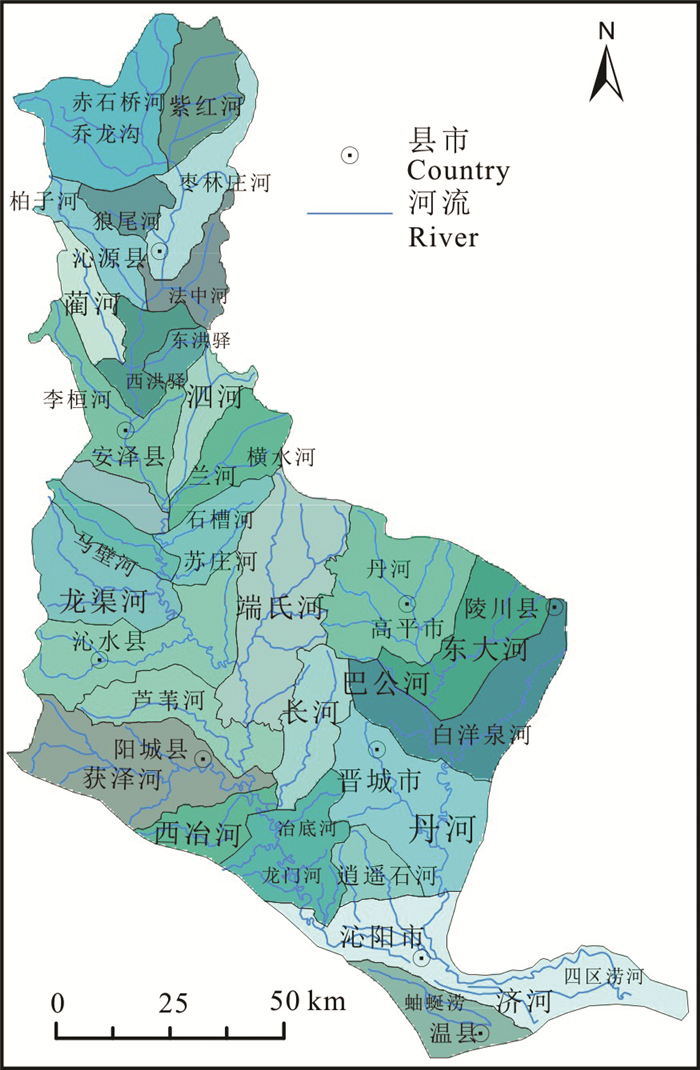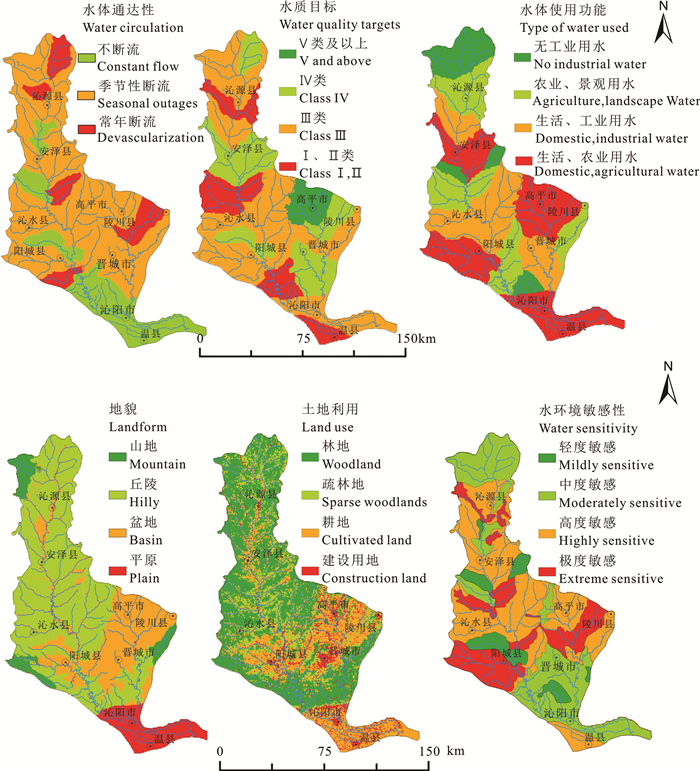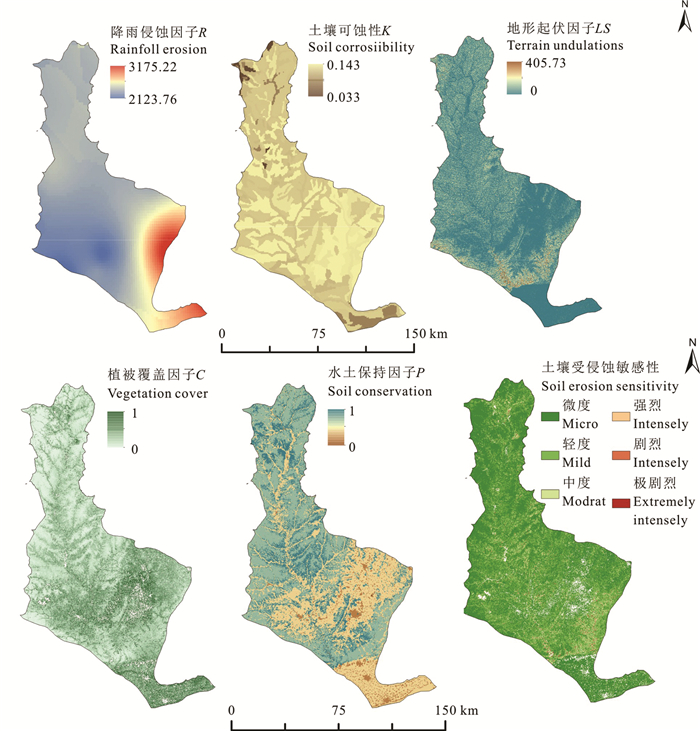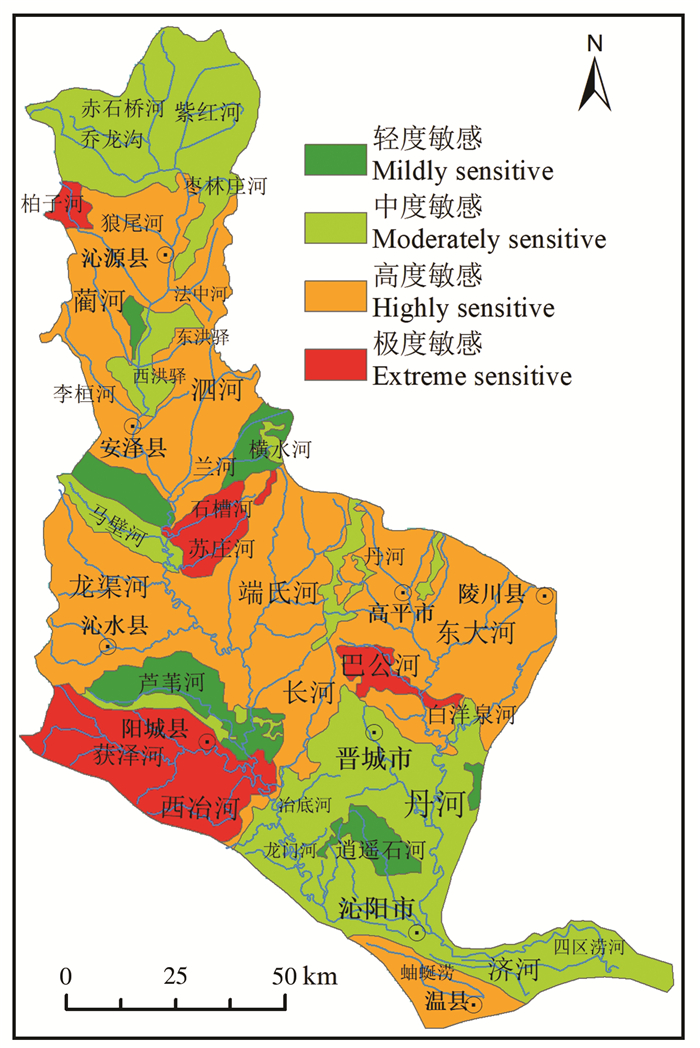Analysis and evaluation of environmental sensitivity in the Qinhe River Basin in the middle reaches of the Yellow River
-
摘要:研究目的
沁河流域作为黄河流域重要的一级支流,也是黄河流域的重要水土保持功能区,当前面临着水环境遭受破坏以及土壤侵蚀这两个敏感环境问题,环境敏感性评价是用于表征外界干扰对自然生态系统可能造成结果的重要指标,对区域建立生态涵养区的环境政策以及有效进行区域生态建设具有重要作用。
研究方法根据研究区面临的不同环境地质问题选取了层次分析法(AHP)与RUSLE模型的评价方法以及相关因子,并结合GIS空间数据技术强大的空间分析功能,将图形处理与空间数据运算结合,生成敏感性评价图,评价结果直观,为环境敏感性分析提供了技术支持。
研究结果针对沁河流域的环境敏感性进行评价,并划分为轻度、中度、高度、极度4类敏感区域,进行统计分析,得出流域内以中、高度敏感区域占比最大,分别占总面积的33.43%、48.56%,同时以各支流流域为依托,针对各类敏感区域的主要环境问题,对其环境现状产生的原因及改善方法提出了相应的调整方案。
结论依据各区域环境现状及敏感性程度提出了沁河全流域的生态环境保护修复思路,构建一个山地生态系统和平原生态系统有机结合的生态网络格局,致力于改善沁河流域的生态环境现状。
创新点:采用了水环境与土壤受侵蚀敏感性相结合的方法去评价流域环境敏感性;以沁河各主要支流为单元提出了各区域生态环境保护思路与修复建议。
Abstract:This paper is the result of hydrological geological survey engineering.
ObjectiveAs an important first-class tributary of the Yellow River Basin, it is also an important functional area for soil and water conservation, the Qinhe River Basin is facing two sensitive environmental problems, water environment destruction and soil erosion. Environmental sensitivity evaluation is an important measure of external interference with natural ecosystems. It plays an important role in carrying out regional ecological protection.
MethodsBased on the different environmental geological problems faced, the evaluation methods of analytic hierarchy (AHP) and RUSLE models were selected. Moreover, combined with the powerful spatial analysis function of GIS spatial data technology, sensitivity evaluation maps were generated by integrating graph processing and spatial data operation. The evaluation results were intuitive, which provided technical support for environmental sensitivity analysis.
ResultsAfter assessment, it can be divided into four types of sensitive areas, that is, mildly sensitive areas, moderately sensitive areas, highly sensitive areas and extremely sensitive areas. Statistical analysis shows that moderate and highly sensitive areas account for the largest proportion, reaching 33.43% and 48.56% of the total area, respectively. At the same time, based on each tributary basin, the author puts forward the corresponding adjustment plans to the causes and improvement methods of the environmental status, aiming at the main environmental problems facing each type of sensitive areas.
ConclusionsAccording to the environmental conditions and sensitivities of each region, the ecological environmental protection and restoration idea was put froward, and an ecological network pattern combining mountain and plain ecosystems is constructed to improve the ecological environment of the Qinhe River Basin.
-
1. 引言
环境敏感性指的是生态环境系统对人类活动干扰和自然环境变化的反映程度,表征一个区域产生生态失衡及出现生态环境问题的可能性的大小(欧阳志云等,2000)。环境敏感性评价就是在不损失或不降低环境质量的情况下,评价生态因子对外界压力或外界干扰适应的能力(闵婕,2004)。敏感性越高的区域越容易产生生态环境问题,是生态环境保护与恢复的重点区域。随着研究的理论方法、数据获取、科技手段的更新发展, 国内外相关领域的专家学者实现了从专题研究向综合研究、从单一方法向方法集成、从数理模型分析向3S空间分析等转变,将环境敏感性研究不断推向深入(周璟等,2012;Rolfhus et al., 2015;Adamczyk et al., 2015;张浪等,2021;武翠翠和王世杰,2021)。有不少学者在这方面做出了有益探索(Wilk et al., 2015;Glisson et al., 2015; 韩双宝等,2021),成果已被广泛应用在不同尺度生态系统的建设和保护中。国外方面,如针对英国西北部霍斯湖的富营养化,研究了沼泽湖泊对营养富集的生态敏感性(Wilk et al., 2015);针对美国大河谷国家纪念碑(GRPO)的生态环境对溪流中汞的生态敏感性(Rolfhus et al., 2015);对美国威斯康星州湿地的沼泽鸟类对植被状况的生态敏感性的研究(Glisson et al., 2015);针对气候对自然及人类系统的敏感性及适应能力进行了评价(Bergengren et al., 2011;Prasannakumar et al., 2011;Adamczyk et al., 2015)。国内方面,由于目前中国生态环境问题突出,针对某种生态环境问题的生态敏感性研究数量较多,研究的主体多为水土流失、土地荒漠化、土地利用等土地问题和洪涝灾害、温度升高等气候问题(张永双等,2017),如关于黄河流域兰州段水土流失与土壤侵蚀的动态敏感性分析(武翠翠和王世杰,2021)、山西煤田生态敏感性(杨琪雪等,2022)、辽宁铁岭地区生态敏感性(陈树旺等,2012)、大辽河地区环境敏感性(陈爽等,2015)、水环境敏感性(陈雯等,2008;周璟等,2012)等研究。近年来,流域和湿地等生态系统与区域人类活动的矛盾日益突出,亟需进行科学的区划保护工作。中国学者进行的此类生态敏感性研究多针对河口三角洲、内流河、特殊生境等生态环境脆弱的区域,例如针对邢江河流域(肖小林等,2015)、大清河流域生态涵养区(贾三满等,2019)、喀斯特岩溶地区(张浪等,2021)进行了相关环境敏感性的研究以及功能区划建议。沁河流域位于黄河中游,是黄河流域重要的给水区以及土壤保持功能区,近年来由于经济的快速发展,流域内存在水资源过度开发和污染物的集中排放问题(韩双宝等,2021;王尧等,2021);煤炭、煤层气的开采以及不合理的建设活动等行为,导致生态环境不断恶化,相继出现了水土流失加剧、河流连通性及水生态系统遭受严重破坏等生态环境问题(程国旗,2016;齐朔风,2016)。
本文依托中国地质调查局廊坊自然资源综合调查中心组织实施的“黄河中游沁河流域生态修复支撑调查”项目,以GIS技术为支撑,结合人类干扰因子和自然因子,采用层次分析法和数学模型法相结合的方法,在流域生态环境现状调查、资料分析的基础上,结合沁河流域生态系统特征及生态环境主要影响因子,充分考虑现存主要的生态环境问题,运用ArcGIS的空间分析功能,评价和分析流域环境敏感性,以期为流域生态环境保护管理、治理决策提供科技支撑,为土地利用综合分区以及空间综合管制的研究提供科学依据。
2. 研究区概况
沁河位于黄河中游,发源于长治市沁源县,自北向南流经长治、临汾、晋城3市,于晋城市阳城县进入河南省,流域内水生生物资源较为丰富,蕴藏着煤、煤气层、锰铁矿、铝铁矿等矿产资源。流域总面积13532 km2,干流全长485 km,其中山西境内12264 km2,干流长363 km,地形北高南低,上游以石质山区为主,中部多为土石丘陵区,河谷两岸土地肥沃,是主要农业区(图 1)。流域属大陆性季风气候,四季分明。多年平均降水量为660~650 mm,多以暴雨的形式出现在7、8月。水面蒸发量约1000 mm。流域地处华北西部的黄土高原东翼,地貌从总体来看是一个被黄土广泛覆盖的山地高原。地貌类型复杂多样,有山地、丘陵、高原、盆地、台地等。大部分地区海拔在1000 m以上,地势高低起伏显著。区内山峦叠嶂,丘陵起伏,沟壑纵横,区内有“多”字形断陷盆地。区内地层主要为中奥陶统峰峰组,上石炭统本溪组、太原组,下二叠统山西组、下石盒子组、上二叠统上石盒子组,新近系上新统,第四系中更新统、上更新统、全新统,总体构造形态基本为东南西高,中北部低的向斜构造,其间有高低起伏的呈放射形的褶曲组,褶曲一般比较开阔,因为受燕山期构造和喜山期活动的影响,区内含有延伸规模较大的断裂带,如晋获褶断带、寺头断层、羊泉断层等,并因此而派生了一系列的小型构造,均受主体构造的影响。
3. 研究方法
根据研究区的生态环境特征及目前存在的主要生态环境问题,参考黄河流域生态系统敏感性分析的已有案例(刘海龙等,2021),本文选取沁河流域内容易导致生态危机的水环境敏感性以及土壤侵蚀敏感性两项指标对流域生态敏感性进行分析研究。
3.1 水环境敏感性评价
根据流域内主要水生态环境问题,并充分参考相关研究文献(周璟等,2012),挑选相关影响因子,通过使用层次分析法(杨澍等,2005)对影响流域水环境敏感性的水体通达性、水体使用功能、水质目标、地貌、土地利用5个指标赋以权重,对流域进行整体评价。
层次分析法是一种定性与定量相结合的分析方法,将决策的目标、考虑的决策准则和决策对象按相互关系分成目标层、指标层和方案层,绘制层次结构图,分别赋值构造判断矩阵计算权重,得出最后的可行方案;本研究所构造的判断矩阵的一致性检验结果小于0.1,通过一致性检验,认为得到的结果可以用来作为沁河流域水环境敏感性评价各个指标的权重。计算公式如下:

(1) 式中:S为水环境敏感性的综合得分值;xi为第i个指标分值;wi为第i个指标权重,决定指标对综合得分的贡献程度;n为评价指标个数。
3.2 土壤侵蚀敏感性评价
土壤侵蚀敏感性是指在自然环境条件下,土壤侵蚀发生的可能性大小。土壤侵蚀敏感性评价是为了识别容易形成土壤侵蚀的区域,评价土壤侵蚀对人类活动的敏感程度(王尧等,2014)。参考国内外土壤侵蚀敏感性评价的研究方法(宁婷等,2019),采用基于修正通用水土流失方程(RUSLE)的土壤保持服务模型开展评价,主要涉及有降雨侵蚀力、土壤可蚀性、地表覆盖管理因子、地形因子、水土保持力。根据各因子的分级及赋值,利用ArcGIS的空间叠加功能计算土壤侵蚀敏感性指数,计算公式如下:

(2) 式中:A为单位面积土壤流失量(土壤侵蚀模数);R为降雨侵蚀力因子;K为土壤可蚀性因子;L和S分别为坡长因子和坡度因子;C为植被覆盖因子;P为水土保持措施因子。
3.3 流域环境敏感性评价
由于水环境敏感性与土壤侵蚀敏感性的指标的计量单位并不统一,因此在计算综合指标前,要进行标准化处理,即把指标的绝对值转化为相对值,从而解决各项不同质指标值的同质化问题。
其次利用差异值原理评价计算权重,对水环境及土壤侵蚀敏感性的权重进行修正。
评价因子权重采用变异系数法确定,根据各个评价单元的各项因子指数,统计得出因子的均值和标准差从而计算变异系数,用各因子的变异系数占总变异系数的比重来确定因子的权重。计算公式如下:

(3) 式中:w为各因子权重;v为评价因子的变异系数;S为评价因子的标准差;X为评价因子的均值;i为评价因子数,i=1,2;xi为第i个指标值;n为评价指标个数。
3.4 数据来源及处理
本文所采用的数据包括文字与影像数据,文字、数据包括:山西省地表水环境功能区划(DB14/ 67-2019)、《晋城市水资源评价》(赵学梅,2008)以及沁河流域年各市区县2020年的统计年鉴(邵俊生,2020;国家统计局长治调查队,2020;临汾市统计局,2020)。影像数据包含DEM(数字高程模型)、土地利用、NDVI、降水量、土壤侵蚀以及沁河流域基础地理信息数据。DEM数据来源于地理空间数据云GDEMV2(http://www.gscloud.cn),分辨率为30 m×30 m;地形数据利用ArcGIS软件平台从DEM数据中获得;土地利用数据来源于全国地理信息资源目录服务系统(https://www.webmap.cn/),分辨率为30 m;NDVI数据基于Landsat 8卫星影像计算而得,分辨率为30 m;降水数据基于中国气象数据网(http://data.cma.cn)中山西、河南二省33个气象站点资料,通过ArcGIS 10.7空间插值后提取所得;土壤质地数据来源于世界土壤数据库(HWSD)提取的中国土壤数据集。
4. 结果与分析
4.1 水环境敏感性评价
综合考虑评价数据的可得性和指标的代表性,选择的评价指标及所赋权重见表 1。
表 1 水环境因子权重与评分标准Table 1. Weight and scoring standard of water environmental factors
4.1.1 流域水环境评价单元划分
参考《山西省地表水水环境功能区划表》以及DEM影像数据,将研究区划分为1个一级评价单元(即沁河干流)和30个二级评价单元(图 2)。
4.1.2 水环境敏感性评价
水体通达性:评价单元内水系与外围水系的沟通程度,以河流的断流情况表示。不断流的河流与外界水体交换条件好,对污染物承受的能力也较强,相应的水环境敏感性相对弱。
水体使用功能:水资源的用途不同,对水质的要求也不相同。如饮用水源地水质安全要求高;农业、景观娱乐用水对水质要求也较高;工业用水对水环境限制则较少。
水质目标:水质目标越高的单元对河流的排污控制越严格。根据收集的资料,将流域水质按Ⅱ类以下、Ⅲ、Ⅳ、Ⅴ类及以上,分为4类赋值。
地貌类型:沁河流域地貌复杂。其中,丘陵与山地具有一定坡度,以坡面径流为主,水环境容量相对较小;低地形成的水网与耕地,水量丰富,水面积大,水面坦荡,但由于外排能力差,环境容量受到一定影响。
土地利用方式:不同土地利用方式对水环境的敏感性也有差异。建设用地增加了不透水层面积,对水环境敏感性较大;而林地由于植被的作用对水环境敏感性相对较小。
将各指标的评价结果通过ArcGIS进行加权叠加,对各单元水环境敏感性进行综合评分,分值越低敏感性越弱。将结果进行聚类,对水环境敏感性划分为轻度、中度、高度、极度4个敏感区(图 3)。
水环境轻度敏感区域共包含4个评价单元,地貌类型以山地丘陵为主,土地利用类型均以林地为主,人口稀少,区域经济发展程度及敏感性均不大,自然生态多维持原始样貌。中度敏感区域共包含8个评价单元,主要位于沁河流域的上游与下游平原区,这些区域自然因素对水环境敏感较强,水质目标较高。高度敏感区域共包含14个评价单元,是整个流域的主要经济区和人口聚集区,多为生活用水,较高的人口密度对水环境的影响较大,使得水环境敏感性较高。极度敏感区域共包含4个评价单元,是流域内城镇发展较早的区域,化工厂密集,加之自然风景景观较多,对水环境的要求程度也较高,因而敏感性较大。
4.2 土壤侵蚀敏感性评价
通过使用RUSLE方程对沁河流域土壤侵蚀敏感性进行评价(齐清等,2009),选取了模型内包含的5个等价影响因子:降雨侵蚀因子(R)、土壤可蚀因子(K)、地形起伏因子(LS)、植被覆盖因子(C)以及水土保持因子(P),将其带入方程内进行分析。
4.2.1 评估因子空间分布特征
(1)降雨侵蚀因子(R)
降雨是导致土壤侵蚀的主要动力因素(王彬等,2013)。沁河流域降水分布的不均匀性,形成了降水引发水土流失的能力差异。降雨侵蚀力因子主要的相关因素是:降雨量、降雨强度、降雨持续时间等(Renard et al., 1994; 章文波等,2002),计算公式如下:

(4) 式中:Rr为第r日的降雨侵蚀力因子;Pr为第r日的日降雨量,需单日降雨量≥12 mm,否则按0计;α,β为降雨侵蚀因子统计系数;Pd12为日降雨量≥12 mm的日降雨量;Py12为日降雨量≥12 mm的年降雨量。
沁河流域侵蚀性降雨量的空间分布规律与年降雨量空间分布呈现一致性,整体呈现从东南向西北递减趋势。东南地区年降雨量丰富,其降雨侵蚀力远大于西北地区。此外,山地地区R值整体较高。
(2)土壤可蚀因子(K)
土壤可蚀性是土壤自身性质对外营力、气候等综合作用所反映出的复杂土壤特性,物理意义为标准小区单位降雨侵蚀力引起的单位面积上的土壤侵蚀量。其强弱主要取决于土壤机械组成和团聚体含量,主要与土壤质地、有机质含量、土体结构、渗透性等土壤理化性质有关(Williams and Arnold, 1997),计算公式为:

(5) 式中:KEPIC为修正前的土壤可蚀性因子;K为修正后的土壤可蚀性因子,W黏、W粉、W砂、W碳分别为黏粒(<0.002 mm)、粉粒(0.002~0.05 mm)、砂粒(0.05~ 2 mm)和有机碳的百分比含量;N为去砂粒外剩余成分占总量百分比。
一般来说,土壤中黏粒含量越高,土壤抵抗侵蚀的能力越强,K值越小;粉粒含量越高,越易发生侵蚀,K值越大。团聚体含量则与土壤可蚀性成反比。沁河流域的土壤可蚀性因子分布沿沟谷两侧区域明显较高。
(3)地形起伏因子(LS)
坡长L和坡度S是衡量地形地貌对土壤侵蚀强度的重要指标,对侵蚀动力起重要作用。坡面径流是土壤侵蚀的主要外营力,在坡度较大的陡地,坡面径流流速快,加强对坡面的冲刷,反之则减弱。在较长的坡面,径流量加大,侵蚀能力越强。沁河流域地形复杂,河流和谷地横穿而过,山地和丘陵地形占多数。因此针对地形起伏程度的算法采用黄土高原地区的修正算法(张宏鸣等,2012)。计算公式如下:

(6) 式中:θ为坡度;ρ为坡长;m为坡长指数;β为细沟和细沟间侵蚀的比率。
本次研究中,沁河流域的地形起伏度在0~405 m。
(4)植被覆盖因子(C)
植被覆盖是控制土壤侵蚀的积极因素。植被覆盖因子取值范围为0~1,C值越大说明所对应土地利用类型的土壤侵蚀越严重(吴昌广等,2012;卢辉雄等,2020)。C的大小与植被覆盖度直接相关,计算公式为:

(7) 式中:C为植被覆盖因子;INDV为归一化植被指数;INDV, max为最大植被覆盖地表的贡献值;INDV, min为最小植被覆盖地表贡献值;RNI、R为近红外波段、红光波段的反射值;CVF为植被覆盖度。
沁河流域平均C值较低,植被覆盖情况较好,林、灌生态系统广泛分布。
(5)水土保持因子(P)
水土保持因子表示某地区在具有一定的水保护力度条件下,土壤侵蚀面积与标准状况下的土壤侵蚀面积之比。其取值范围为0~1,0值表示不会发生土壤侵蚀,1值表示水土保持措施较弱或者无水土保持措施。参考前人研究成果(宁婷等,2019),P因子的赋值见表 2。
表 2 水土保持因子P赋值Table 2. Assignment of water and soil conservation factor P
4.2.2 流域土壤侵蚀特征
按照上述方法逐网格计算2020年沁河流域单位面积土壤流失量,按照《土壤侵蚀分类分级标准》(SL190-2007)对土壤侵蚀强度进行分级,利用GIS生成沁河流域土壤侵蚀强度分布图。
沁河流域整体土壤侵蚀敏感程度较低,土壤侵蚀强度较高的区域主要集中在沁河两岸的山地丘陵,而沁河上游和沟谷地区土壤侵蚀强度较低。
沁河流域土壤微度、轻度、中度、强烈、极强烈、剧烈侵蚀面积分别为4295.01 km2、7573.7 km2、717.1 km2、123.3 km2、25.9 km2、0.16 km2,分别占流域面积的33.72%、59.46%、5.63%、0.97%、0.22%、0.012%(表 3)。其中侵蚀敏感性中度及以下土壤侵蚀面积12585.9 km2、占总面积的98.81%,表明沁河流域土壤侵蚀以中度以下为主。这与《山西省主体功能区规划》❶、《山西省生态功能区划》❷中关于沁河流域作为黄河流域主要的土壤保持生态功能区的事实相符(图 4)。
表 3 沁河流域各级土壤侵蚀面积统计表Table 3. Statistics of soil erosion area at all levels in the Qinhe River Basin
4.3 环境敏感性评价
由于水环境敏感性与土壤侵蚀敏感性的指标计量单位并不统一,因此在计算综合指标前,要进行标准化处理,即把指标的绝对值转化为相对值,从而解决各项不同指标值的同质化问题。其次使用差异系数法对水环境及土壤侵蚀敏感性的权重进行修正(吴昆等,2018;张会霞和刘丽荣,2020),利用差异值原理评价计算权重,得到综合考虑主客观因素的综合权重(表 4)。
表 4 沁河流域环境敏感性特征值Table 4. Characteristic values of environmental sensitivity of the Qinhe River Basin
根据自然断点法(丁徽等,2020;孔伟等,2020)进行等级划分,将各评价单元划分为轻度敏感区域、中度敏感区域、高度敏感区域、极度敏感区域4种生态环境类型区域(图 5)。
通过对沁河环境敏感性总体空间分布特征进行分析可知,沁河流域生态敏感性以中、高度为主要敏感类型(表 5)。
表 5 沁河流域环境敏感性面积统计表Table 5. Statistics of environmental sensitivity area in the Qinhe River Basin
5. 讨论与建议
沁河流域内的生态环境问题,主要是由于社会经济快速发展所造成的,为促进经济与环境的可持续性发展,建议对流域生态环境实施保护修复。在了解各区域生态环境背景的基础上,从保护生态环境,解决主要问题的角度出发,探讨各类型区域的生态结构优化,以达到有效保护生态环境,支撑生态修复支撑的目的。
(1)沁河流域的环境轻度敏感区域主要位于苗家沟、逍遥石河、横水河以及芦苇河这些二级支流区域内,这些地区地形起伏较大,人口罕见,土地利用类型多为林地。生态环境的原始程度较高。划分这一地区的依据主要为区域内水环境及土壤受侵蚀敏感性均不高,导致整体敏感性较低。这些区域内应主要着眼于现有生态环境状况的保持,以植被保护和自然生态维护为主,加强沁河的水源涵养能力,继续增加林、草、灌的面积,扩大植被覆盖率,封育结合,建立以保护为主的自然生态模式,同时也应对植被的组成方式进行合理分配,如采取乔灌草混交等模式,并遵循因地制宜、适地适树的原则。
(2)环境中度敏感区域主要位于沁河上游的紫红河、乔龙沟、赤石桥河流域以及沁、丹河的下游地区,占流域总面积比重较大,上游区域多处山间丘陵地带,土壤受侵蚀敏感性一般,加之近年来由于河道流量减小加之对水质目标要求较高,因此水环境敏感性较其他区域高,导致整体环境敏感性较高,紫红河、乔龙沟、赤石桥河流域内的主要环境目标应为继续优化森林植被配比,加强污水排放监管力度,同时在水质目标较高的主要支流(如马壁河、西洪驿等)两侧构建河流水系绿色廊道,以减轻支流水系的污染,同时减少排入干流的污染,在流域内的后人工形成的水库(如张峰水库)周边应增加林地与园地面积,以维持自然生态景观功能。下游地区主要集中于晋城市辖区与河南省境内,沁河下游晋城地区是近年流域内经济高速发展的区域,因此需要做到经济发展与生态保护的良好契合,可将区域内的城镇、工矿用地外围的用地调整为林、灌、草地作为护栏,以起到阻拦工业、生活废水,减小污染。同时也要完善污水处理厂管网配套,继续推进污水处理设施建设,提升城镇污水处理水平。同时区域内的生态环境保护也应与湿地保护区建设(丹河下游的人工湿地工程)、土地开发(百里沁河经济带)等结合起来,这样不仅可起到水分蓄积和污水净化作用,还可提升环境美学价值。在河流两岸构建以河流水系为主的绿色生态廊道,增强绿色自然景观,以减小可能的水土污染,在河南省沁阳境内土地利用类型主要为耕地,这一区域内的耕地、果园应以农业生产为主,还可结合旅游开发,发展观光农业,同时应在耕地之间增加林地,起到隔离、减小污染的作用。
(3)环境高度敏感区域主要位于沁河中、上游,多位于沁、丹河河道两侧及其支流流域,如上游的狼尾河、泗河、法中河以及蔺河,中游的龙渠河、端氏河、长河及高平市境内的东大河与白洋泉河,这些区域是流域内高度城镇化的区域、人口聚集程度高、工厂密集度大、植被覆盖率低,因而整体环境敏感性较高。在区域内应以建设符合生态要求的绿色板块为主要手段,整体提高城镇生态系统的稳定性,同时也应尽量避免城镇化的无序扩张。这些区域工业发展较早,可适当减少一些工业用地,建立集中的工业园区,对于闲置的工业建设用地可转变为林地、耕地。该区域内敏感性较高的区域(如端氏河上游)应增加林地面积,在主要支流(如龙渠河、长河、端氏河)两侧构建河流水系的绿色廊道,以减小进入下游农耕区的污染,白洋泉河流域存在一定的耕地,应将坡度较大的耕地尽可能转化为林地、草地,退耕还林,减小因水土流失带来的污染。对于坡度较小的耕地,不进行深耕,避免加重水土流失,从合理利用自然资源与保护生态环境的角度出发,发展特色农业。
(4)环境极度敏感区域主要位于阳城县境内的获泽河、西冶河流域、沁河中游的苏庄河、石槽河、巴公河流域两岸以及上游的柏子河下游,总体面积较小,多沿沁河支流两岸分布,这些区域内往往自然植被覆盖较差,巴公河一带是丹河城镇工业发展较早区域,石槽河与苏庄河沿岸有多个煤化工加工厂,而阳城县境内为晋城地区煤炭、煤层气开发的重点区域,这些区域地表覆盖多为第四系黄土层,沟壑发育,地形起伏较大,局部剥蚀侵蚀严重,受气候影响,夏季极易形成暴雨,遇短时强降雨后,雨水迅速汇集成地表径流,造成水土流失,引发山洪灾害,区域内水环境敏感性与土壤侵蚀敏感性相对高,在区域内应注重发展城镇绿色景观廊道,通过建设符合绿色生态发展要求的通道,提高城镇整体生态系统的稳定性,保护生物多样性,防风固沙,防治水土流失,同时也可因城市发展的无序扩张造成的自然生态破坏。这些区域内也可适当压缩一些工业用地,如获泽河、西冶河流域内均可建立集中的工业园区,对于离水体较近的工业用地可转换为林地、耕地。同时也应在园区周围建立绿色廊道,用以过虑污染物、阻隔工业废水,保护水环境。苏庄河、石槽河这些区域内,应注重专项治理,提高工业污水、生活废水的排放指标,优化水资源配置,提高用水效益,压减地下水超采区开采量,开展河道整治,河堤修复,改善人居环境。在阳城县境内资源开采影响严重区域,合理确定煤炭和煤层气开采规模,并持续推进采空区综合治理。同样该区域内坡度较大的耕地,对于这类耕地以退耕还林为主,此外,还应通过采取建设景观林地、经济林、防护林屏障体系、城市绿地生态体系,因地制宜地去增加森林面积。
6. 结论
(1)从水环境与土壤两个方面针对沁河流域环境敏感性进行分析评价,并根据不同区域的环境现状提出了相应的建议。依照本文的研究结果,沁河流域的环境敏感性主要以中、高度敏感区域占比较大,分别占总面积的33.43%、48.56%,修复工作应关注多方面的自然环境要素,因地制宜,实施山水林田的综合治理及修复的措施。
(2)沁河流域整体地势呈现出了四周高、中间低的格局,因此在上游、下游自然原始状态较好的轻、中度敏感区域应以维护现有的自然格局为主,辅以人工措施,选取优势树种,强调森林系统对四周山地的土壤保护及水源涵养功能的作用,减轻向中度经济区排入的污染物。
(3)对于沁河中部的敏感性较高区域,主要是由于人口城镇化、工业区密集导致的对环境压力较大,整体敏感度较高,因此要加强城镇内的绿色景观建设,建立集中的工业生产园区,耕作区内发展生态农业,改善内部水系廊道,疏通河道,在重点河流两岸构建景观生态廊道,调节沁河干流与主要支流的河流状况,保证正常的水系功能。
(4)对于流域内敏感性强烈的区域,如矿区、化工厂,要加强整体治理,限制地下水开采、建立严格的采、排规定、针对废弃矿场进行矿山公园建设,同时在沁、丹河两岸及地势陡峭的砂岩、石灰岩区域要做到退耕还林,加固土壤,防治夏季降水造成水土流失及污染,发挥好沁河流域作为黄河中游重要的水土保持功能区的作用,同时也应在考虑社会经济、符合环保要求的基础上在沁河流域内敏感性强烈的地区划定适度开发区和禁止开发区,同时加快推进沁河流域的生态补偿机制的执行工作,促进流域生态环境治理进入良性循环状态。
注释
❶山西省人民政府. 2014. 山西省主体功能区规划[R].1-118.
❷山西省人民政府. 2008. 山西省生态功能区规划[R].1-19.
-
表 1 水环境因子权重与评分标准
Table 1 Weight and scoring standard of water environmental factors

表 2 水土保持因子P赋值
Table 2 Assignment of water and soil conservation factor P

表 3 沁河流域各级土壤侵蚀面积统计表
Table 3 Statistics of soil erosion area at all levels in the Qinhe River Basin

表 4 沁河流域环境敏感性特征值
Table 4 Characteristic values of environmental sensitivity of the Qinhe River Basin

表 5 沁河流域环境敏感性面积统计表
Table 5 Statistics of environmental sensitivity area in the Qinhe River Basin

-
Adamczyk J, Robert D. 2017. Analysis of the sensitivity of the ecological effects for the investment based on the thermal insulation of the building: A polish case study[J]. Journal of cleaner production, (162): 856-864.
Bergengren J C, Waliser D E, Yung Y L. 2011. A biospheric view of climate change[J]. Climatic Change, 107(3/4): 433-457.
Changzhi Investigation Team of the National Bureau of Statistics. 2020. Changzhi Statistical Yearbook 2020[M]. Beijing: China Statistics Press, 1-688(in Chinese).
Chen Shuang, Ma Anqing, Ma Bingran, Li Zhengyan, Jiao Junchao, Cui Jinglan. 2015. Assessment on eco-environmental sensitivity in Daliaohe Area[J]. Periodical of Ocean University of China, 45 (9): 103-108(in Chinese with English abstract).
Chen Shuwang, Xing Dehe, Ding Qiuhong, Zheng Yuejuan, Gao Fei, Bian Xiongfei, Zhang Zhibin, Antonina A Zhukovskaya, Irina V Ershova, Nadezhda A Tomilovskaya. 2012. Ecogeological survey and Evaluation: A case study of Tieling Area, Liaoning Province[J]. Geology and Resources, 21(6): 540-545(in Chinese with English abstract). doi: 10.3969/j.issn.1671-1947.2012.06.008
Chen Wen, Huang Zhenkun, Zhao Haixia, Cui Xu. 2008. Regionalization of water environmental risk and spatial development guidance: A case study of Wuxi City[J]. Journal of Lake Science, (1): 129-134(in Chinese with English abstract). doi: 10.3321/j.issn:1003-5427.2008.01.020
Cheng Guoqi. 2016. Analysis of eco-environmental problems and restoration suggestions in Qin River Basin[J]. Shanxi Water Resources, (7): 10-11(in Chinese). doi: 10.3969/j.issn.1004-7042.2016.07.007
Ding Hui, Zhao Xiaomin, Guo Xi. 2020. Evaluation of ecological sensitivity in Poyang Lake area of Jiangxi Province[J]. Research of Soil and Water Conservation, 27(1): 257-264(in Chinese with English abstract).
Glisson W J, Brady R S. 2015. Sensitivity of secretive marsh birds to vegetation condition in natural and restored wetlands in Wisconsin[J]. Journal of Wildlife Management, 79(7): 1101-1116. doi: 10.1002/jwmg.937
Han Shuangbao, Li Fucheng, Wang Sai, Li Haixue, Yuan Lei, Liu Jingtao, Shen Haoyong, Zhang Xueqing, Li Changqing, Wu Xi, Ma Tao, Wei Shibo, Zhao Minmin. 2021. Groundwater resource and eco-environmental problem of the Yellow River Basin[J]. Geology in China, 48(4): 1001-1019(in Chinese with English abstract).
Jia Sanman, Zhang Qun, Lu Lu. 2019. Evaluation on eco-environment sensibility in ecological conservation area of Daqing River Watershed of Beijing[J]. Urban Geology, 14(3): 1-6(in Chinese with English abstract). doi: 10.3969/j.issn.1007-1903.2019.03.001
Kong Wei, Ren Liang, Liu Lu, Li Yanlong. 2020. Vulnerability characteristics and influencing factors of social-economicecological system of tourist destination in Beijing-Tianjin-Hebei ecological conservation area[J]. Bulletin of Soil and Water Conservation, 40(4): 211-218(in Chinese with English abstract).
Li Haixue, Han Shuangbao, Wu Xi, Wang Sai, Liu Weipo, Ma Tao, Zhang Mengnan, Wei Yutao, Yuan Fuqiang, Yuan Lei, Li Fucheng, Wu Bin, Wang Yushan, Zhao Minmin, Yang Hanwen, Wei Shibo. 2021. Distribution, characteristics and influencing factors of fresh groundwater resources in the Loess Plateau[J]. China Geology, (4): 509-526.
Linfen Municipal Bureau of Statistics. 2020. Linfen Statistical Yearbook 2020[M]. Beijing: China Statistics Press, 1-482.
Liu Baoyuan, Nearing M A, Risse L M. 1994. Slope gradient effects on soil loss for steep slopes[J]. Transactions of the Asae, 37 (6): 1835-1840. doi: 10.13031/2013.28273
Liu Hailong, Wang Weiqiao, Wang Yuefei, DingYanan, Tian Qingchun. 2021. Comprehensive evaluation of ecological sensitivity and the characteristics of spatiotemporal variations in Fenhe River Basin[J]. Acta Ecologica Sinica, 41 (10): 3952-3964(in Chinese with English abstract).
Lu Huixiong, Nie Zhenlong, Liu Min, Feng Bo, Cheng Xu, Wang Jinzhe, Wang Qian, Cui Haohao, Fan Fang. 2020. Research on land cover changes in Shiyang River Basin in recent 50 years based on RS and GIS[J]. Geology And Resources, 29(2): 165-171, 179(in Chinese with English abstract). doi: 10.3969/j.issn.1671-1947.2020.02.008
Meng Hui, Li Chunyan, Zhang Ruolin, Liu Ke, Li Ruimin. 2021. Assessment of carrying capacity of national geological environments in China[J]. Geological Bulletin of China, 40(4): 451-459(in Chinese with English abstract).
Min Jie. 2004. Study on Regional Eco-environmental Sensitivity Assessment Based on GIS and RS Technology[D]. Chongqing: Chongqing Normal University (in Chinese).
Ning Ting, Guo Xinya, Rong yuejing, Du Shixun, Li Chao. 2019. Evaluation of soil conservation function importance of ecosystems in Shanxi Province based on RUSLE model[J]. Bulletin of Soil and Water Conservation, 39(6): 205-210(in Chinese with English abstract).
Ouyang Zhiyun, Wang Xiaoke, Miao Hong. 2000. China's ecoenvironmental sensitivity and its spatial heterogeneity[J]. Acta Ecologica Sinica, 20(1): 10-13(in Chinese with English abstract).
Prasannakumar V, Vijith H, Geetha N, Shiny R. 2011. Regional scale erosion assessment of a sub-tropical highland segment in the Western Ghats of Kerala, South India[J]. Water Resources Management, 25(14): 3715-3727. doi: 10.1007/s11269-011-9878-y
Qi Qing, Wang Tianming, Kou Xiaojun, Ge Jianping. 2009. Quantitative assessment of soil erosion in small watershed in loess plateau based on GIS[J]. Research on Soil and Water Conservation, 16(3): 1-5, 37(in Chinese with English abstract).
Qi Shuofeng. 2016. Ecosystem health assessment of Qin River Basin in Shanxi Province[J]. Resources Economization & Environmental Protection, (5): 176, 180(in Chinese).
Renard K G, Freimund J R. 1994. Using monthly precipitation data to estimate the R-factor in the revised USLE[J]. Joumal of Hydrology, 157: 287-300. doi: 10.1016/0022-1694(94)90110-4
Rolfhus K R, Wiener J G, Haro R J, Sandheinrich M B, Bailey S W, Seitz B R. 2015. Mercury in streams at Grand Portage National Monument (Minnesota, USA): Assessment of ecosystem sensitivity and ecological risk[J]. Science of the total environment, 514(1): 192-201.
Shao Junsheng. 2020. Jincheng Yearbook (2020)[M]. Beijing: Parkstone Press, 1-353.
Wang Bin, Zheng Fenli, Römkens M J M. 2013. Soil Erodibility for Water Erosion: A Review[J]. Research on Soil and water conservation, 20 (1): 277-286(in Chinese with English abstract).
Wang Yao, Cai Yunlong, Pan Mao. 2014. Soil erosion simulation of the Wujiang River Basin in Guizhou Province based on GIS, RUSLE and ANN[J]. Geology in China, (5): 1735-1747(in Chinese with English abstract). doi: 10.3969/j.issn.1000-3657.2014.05.027
Wang Yao, Chen Ruishan, Guo Chihui, Xia Zilong. 2021. Changes of resource and environmental pattern of the Yellow River Basin in the past 40 years and suggestions on geological work[J]. Geology in China, 48(1): 1-20(in Chinese with English abstract).
Wiik E, Bennion H, Sayer C D, Davidson T A, McGowan S, Patmore I R, Clarke S J. 2015. Ecological sensitivity of marl lakes to nutrient enrichment: Evidence from Hawes water, UK[J]. Freshwater Biology, 60(11): 2226-2247. doi: 10.1111/fwb.12650
Williams J R, Arnold J G. 1997. A System of erosion-sediment yield models[J]. Soil Technology, 11(1): 43-55. doi: 10.1016/S0933-3630(96)00114-6
Wu Changguang, Li Sheng, Ren Hua. 2012. Quantitative estimation of vegetation cover and management factor in USLE and RUSLE models by using remote sensing data: A review[J]. Journal of Applied Ecology, 23(6): 1728-1732(in Chinese with English abstract).
Wu Cuicui, Wang Shijie. 2021. Sensitivity evaluation of soil erosion in Lanzhou section of the Yellow River Basin[J]. Science Technology and Engineering, 21(29): 12390-12397 (in Chinese with English abstract). doi: 10.3969/j.issn.1671-1815.2021.29.006
Wu Kun, Peng Hongxia, Li Jiangfeng, Chen Wanxu. 2018. Land ecological sensitivity analysis of Lingbao City based on the coefficient of variation method[J]. Hubei Agricultural Sciences, 57(14): 32-37(in Chinese with English abstract).
Xiao Xiaolin, Lan Anjun, Xiong Kangning. 2015. Analysis on ecological environmental sensitivity of Xinjiang River Basin based on GIS[J]. Yangtze River, 46 (9): 68-72, 110(in Chinese with English abstract).
Yang Qixue, Pan Changyi, Wu Shurong. 2022. Ecological environment sensitivity assessment of coalfields in Shanxi Province based on GIS[J]. Chinese Agricultural Science Bulletin, 38(3): 59-66 (in Chinese).
Zhang Hongming, Yang Qinke, Li Rui, Liu Qingrui. 2012. Research on the estimation of slope length in distributed watershed erosion[J]. Journal of Water Conservancy, 43(4): 437-444(in Chinese with English abstract).
Zhang Huixia, Liu Lirong. 2020. Evaluating ecological environmental sensitivity in poor county of Lüliang mountain area based on GIS[J]. Ecological Science, 39(6): 30-37(in Chinese with English abstract).
Zhang Lang, He Zhonghua, Xia Chuanhua, Ren Rongyi. 2021. GISbased evaluation of ecological sensitivity of karst areas[J]. Guizhou Science, 39(2): 45-52(in Chinese with English abstract).
Zhang Wenbo, Xie Yun, Liu Baoyuan. 2002. Rainfall erosivity estimation using daily rainfall amounts[J]. Scientia Geographica Sinica, (6): 705-711(in Chinese with English abstract). doi: 10.3969/j.issn.1000-0690.2002.06.012
Zhang Yongshuang, Sun Lu, Yin Xiulan, Meng Hui. 2017. Progress and prospect of research on environmental geology of China: A review[J]. Geology in China, 44(5): 901-912(in Chinese with English abstract).
Zhao Xuemei. 2008. Jincheng City Water Resources Assessment[M]. Beijing: China Water & Power Press, 1-280.
Zhou Jing, Liu Yong, Guo Huaicheng, Zhao Haisheng, Yan Xiaopin, Zhang Zhenzhen. 2012. Water environmental constraint regionalization and landscape pattern optimization for the Qin River Basin[J]. Environmental Science Research, 25(5): 481-488(in Chinese with English abstract).
陈树旺, 邢德和, 丁秋红, 郑月娟, 高飞, 卞雄飞, 张志斌, 商翎, Antonina A Zhukovskaya, Irina V Ershova, Nadezhda A Tomilovskaya. 2012. 生态地质调查评价: 以辽宁铁岭地区为例[J]. 地质与资源, 21(6): 540-545. https://www.cnki.com.cn/Article/CJFDTOTAL-GJSD201206009.htm 陈爽, 马安青, 马冰然, 李正炎, 焦俊超, 崔静岚. 2015. 大辽河地区环境敏感性评价[J]. 中洋大学学报(自然科学版), 45(9): 103-108. https://www.cnki.com.cn/Article/CJFDTOTAL-QDHY201509016.htm 陈雯, 禚振坤, 赵海霞, 崔旭. 2008. 水环境约束分区与空间开发引导研究——以无锡市为例[J]. 湖泊科学, (1): 129-134. https://www.cnki.com.cn/Article/CJFDTOTAL-FLKX200801023.htm 程国旗. 2016. 沁河流域生态环境问题分析及修复建议[J]. 山西水利, (7): 10-11. https://www.cnki.com.cn/Article/CJFDTOTAL-SXLS201607010.htm 丁徽, 赵小敏, 郭熙. 2020. 江西省鄱阳湖区生态敏感性评价[J]. 水土保持研究, 27(1): 257-264. https://www.cnki.com.cn/Article/CJFDTOTAL-STBY202001038.htm 国家统计局长治调查队. 2020. 长治统计年鉴2020[M]. 北京: 中国统计出版社, 1-688. 韩双宝, 李甫成, 王赛, 李海学, 袁磊, 刘景涛, 申豪勇, 张学庆, 李长青, 吴玺, 马涛, 魏世博, 赵敏敏. 2021. 黄河流域地下水资源状况及其生态环境问题[J]. 中国地质, 48(4): 1001-1019. http://geochina.cgs.gov.cn/geochina/article/abstract/20210402?st=search 贾三满, 张群, 路璐. 2019. 北京大清河流域生态涵养区环境敏感性评价[J]. 城市地质, 14(3): 1-6. https://www.cnki.com.cn/Article/CJFDTOTAL-CSDZ201903002.htm 孔伟, 任亮, 刘璐, 李艳龙. 2020. 京津冀生态涵养区旅游地社会-经济-生态系统脆弱性特征及其影响因素[J]. 水土保持通报, 40(4): 211-218. https://www.cnki.com.cn/Article/CJFDTOTAL-STTB202004029.htm 临汾市统计局. 2020. 临汾统计年鉴2020[M]. 北京: 中国统计出版社, 1-482. 刘海龙, 王炜桥, 王跃飞, 丁娅楠, 田庆春. 2021. 汾河流域生态敏感性综合评价及时空演变特征[J]. 生态学报, 41(10): 3952-3964. https://www.cnki.com.cn/Article/CJFDTOTAL-STXB202110021.htm 卢辉雄, 聂振龙, 刘敏, 冯博, 程旭, 王金哲, 王茜, 崔浩浩, 范芳. 2020. 基于RS和GIS的石羊河流域近50年土地覆被类型变化研究[J]. 地质与资源, 29(2): 165-171, 179. https://www.cnki.com.cn/Article/CJFDTOTAL-GJSD202002008.htm 孟晖, 李春燕, 张若琳, 刘可, 李瑞敏. 2021. 全国地质环境承载能力评价[J]. 地质通报, 40(4): 451-459. https://www.cnki.com.cn/Article/CJFDTOTAL-ZQYD202104001.htm 闵婕. 2004. 基于GIS与RS技术的区域生态环境敏感性评价研究[D]. 重庆: 重庆师范大学, 1-91. 宁婷, 郭新亚, 荣月静, 杜世勋, 李超. 2019. 基于RUSLE模型的山西省生态系统土壤保持功能重要性评估[J]. 水土保持通报, 39(6): 205-210. https://www.cnki.com.cn/Article/CJFDTOTAL-STTB201906032.htm 欧阳志云, 王效科, 苗鸿. 2000. 中国环境敏感性及其区域差异规律研究[J]. 生态学报, (1): 10-13. https://www.cnki.com.cn/Article/CJFDTOTAL-STXB200001001.htm 齐清, 王天明, 寇晓军, 葛剑平. 2009. 基于GIS的黄土高原小流域土壤侵蚀定量评价[J]. 水土保持研究, 16(3): 1-5, 37. https://www.cnki.com.cn/Article/CJFDTOTAL-STBY200903000.htm 齐朔风. 2016. 山西省沁河流域生态系统健康评估[J]. 资源节约与环保, (5): 176, 180. https://www.cnki.com.cn/Article/CJFDTOTAL-ZYJH201605165.htm 邵俊生. 2020. 晋城年鉴(2020)[M]. 北京: 方志出版社, 1-353. 王彬, 郑粉莉, Römkens M J M. 2013. 水蚀过程的土壤可蚀性研究述评[J]. 水土保持研究, 20(1): 277-286. https://www.cnki.com.cn/Article/CJFDTOTAL-STBY201301056.htm 王尧, 陈睿山, 郭迟辉, 夏子龙. 2021. 近40年黄河流域资源环境格局变化分析与地质工作建议[J]. 中国地质, 48(1): 1-20. http://geochina.cgs.gov.cn/geochina/article/abstract/20210101?st=search 王尧, 蔡运龙, 潘懋. 2014. 贵州省乌江流域土壤侵蚀模拟——基于GIS、RUSLE和ANN技术的研究[J]. 中国地质, 41(5): 1735-1747. http://geochina.cgs.gov.cn/geochina/article/abstract/20140527?st=search 吴昌广, 李生, 任华. 2012. USLE/RUSLE模型中植被覆盖管理因子的遥感定量估算研究进展[J]. 应用生态学报, 23(6): 1728-1732. https://www.cnki.com.cn/Article/CJFDTOTAL-YYSB201206042.htm 吴昆, 彭红霞, 李江风, 陈万旭. 2018. 基于变异系数法的灵宝市土地生态敏感性分析[J]. 湖北农业科学, 57(14): 32-37. https://www.cnki.com.cn/Article/CJFDTOTAL-HBNY201814008.htm 武翠翠, 王世杰. 2021. 黄河流域兰州段土壤侵蚀敏感性评价[J]. 科学技术与工程, 21(29): 12390-12397. https://www.cnki.com.cn/Article/CJFDTOTAL-KXJS202129006.htm 肖小林, 兰安军, 熊康宁. 2015. 基于GIS的邢江河流域环境敏感性分析[J]. 人民长江, 46(9): 68-72, 110. https://www.cnki.com.cn/Article/CJFDTOTAL-RIVE201509016.htm 杨琪雪, 潘换换, 吴树荣. 2022. 基于GIS的山西省煤田环境敏感性评价[J]. 中国农学通报, 38(3): 59-66. https://www.cnki.com.cn/Article/CJFDTOTAL-ZNTB202203009.htm 杨澍, 初禹, 杨湘奎, 娄本君. 2005. 层次分析法(AHP)在三江平原地质环境质量评价中的应用[J]. 地质通报, 24(5): 485-490. https://www.cnki.com.cn/Article/CJFDTOTAL-ZQYD200505016.htm 张宏鸣, 杨勤科, 李锐, 刘晴蕊. 2012. 流域分布式侵蚀学坡长的估算方法研究[J]. 水利学报, 43(4): 437-444. https://www.cnki.com.cn/Article/CJFDTOTAL-SLXB201204011.htm 张会霞, 刘丽荣. 2020. 基于GIS的吕梁山区贫困县环境敏感性评价[J]. 生态科学, 39(6): 30-37. https://www.cnki.com.cn/Article/CJFDTOTAL-STKX202006005.htm 张浪, 贺中华, 夏传花, 任荣仪. 2021. 基于GIS的喀斯特地区环境敏感性评价[J]. 贵州科学, 39(2): 45-52. https://www.cnki.com.cn/Article/CJFDTOTAL-GZKX202102009.htm 张永双, 孙璐, 殷秀兰, 孟晖. 2017. 中国环境地质研究主要进展与展望[J]. 中国地质, 44(5): 901-912. http://geochina.cgs.gov.cn/geochina/article/abstract/20170505?st=search 章文波, 谢云, 刘宝元. 2002. 利用日雨量计算降雨侵蚀力的方法研究[J]. 地理科学, (6): 705-711. https://www.cnki.com.cn/Article/CJFDTOTAL-DLKX200206011.htm 赵学梅. 2008. 晋城市水资源评价[M]. 北京: 中国水利水电出版社, 1-280. 周璟, 刘永, 郭怀成, 赵海生, 颜小品, 张祯祯. 2012. 沁河流域水环境约束分区与景观格局优化[J]. 环境科学研究, 25(5): 481-488. https://www.cnki.com.cn/Article/CJFDTOTAL-HJKX201205002.htm -
期刊类型引用(4)
1. 杨智楷,左其亭,巴音吉,秦西,纪义虎. 基于InVEST的沁河流域产水量-碳储量时空演变及关联分析. 人民黄河. 2025(03): 1-9 .  百度学术
百度学术
2. 刘淼,刘义,苗志加,许凯然,史佩东. 沁河流域上游沁源县生态地质脆弱性评价与分区. 中国地质调查. 2024(02): 97-107 .  百度学术
百度学术
3. 赵晶. 基于AHP-CV法的赤水市生态敏感性评价. 农业技术与装备. 2024(10): 37-41 .  百度学术
百度学术
4. 杨晓芳,罗志军. 居民生态福祉导向的国土空间生态网络构建——以南昌市为例. 江西农业大学学报. 2023(05): 1297-1310 .  百度学术
百度学术
其他类型引用(2)



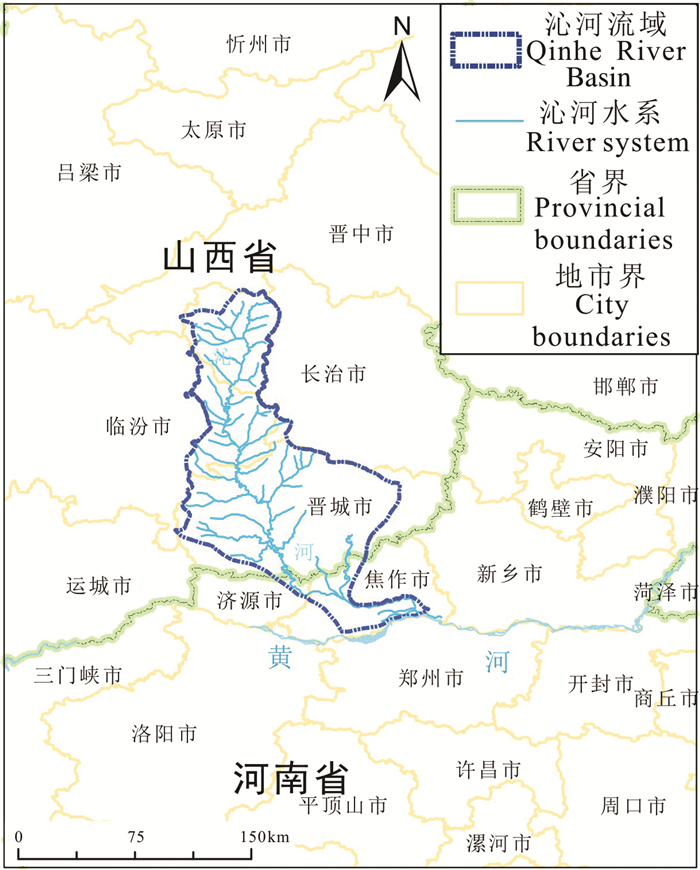
 下载:
下载:
